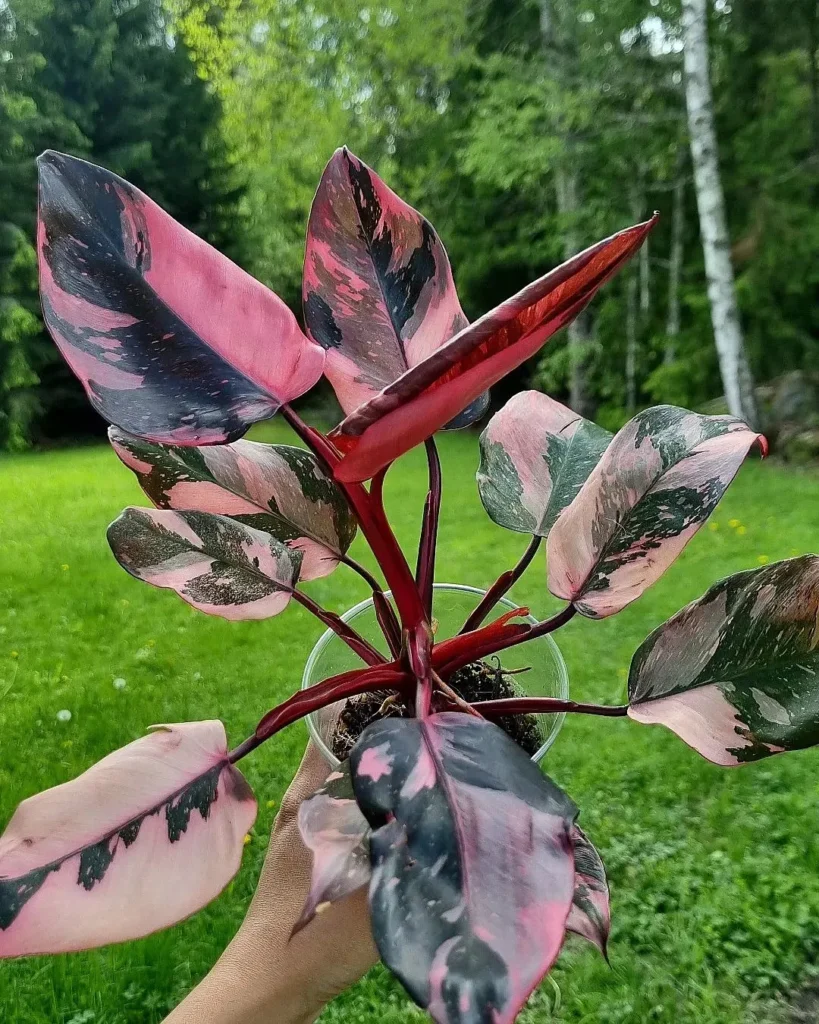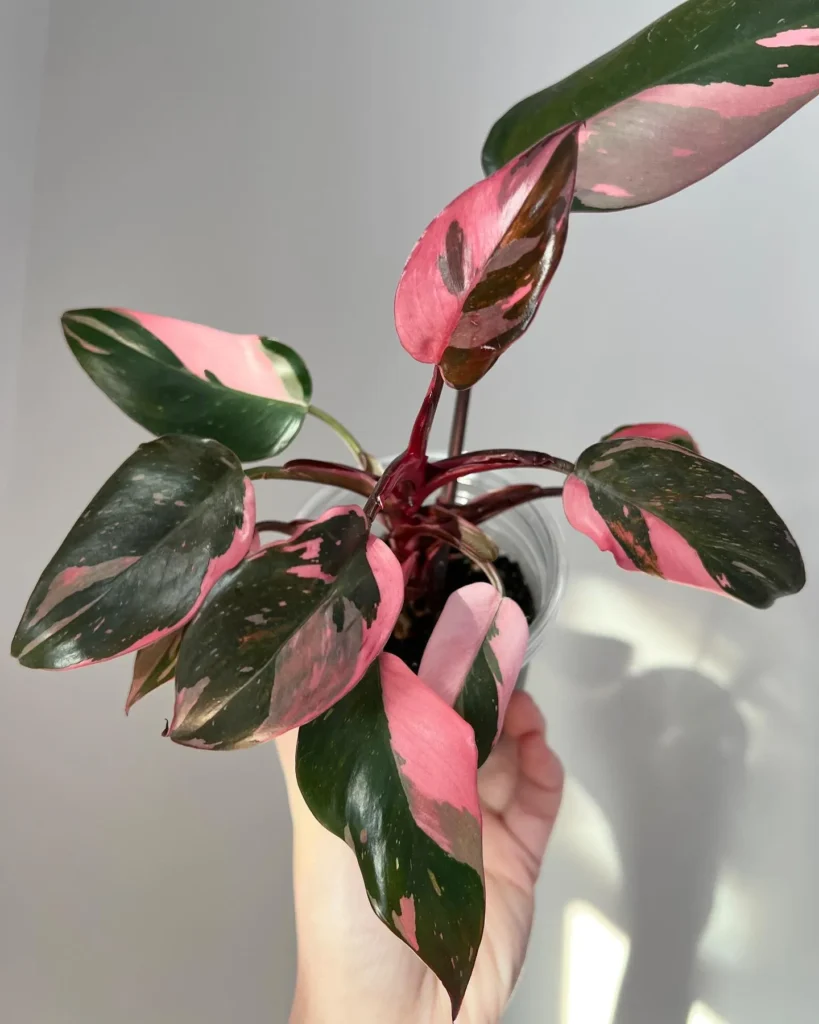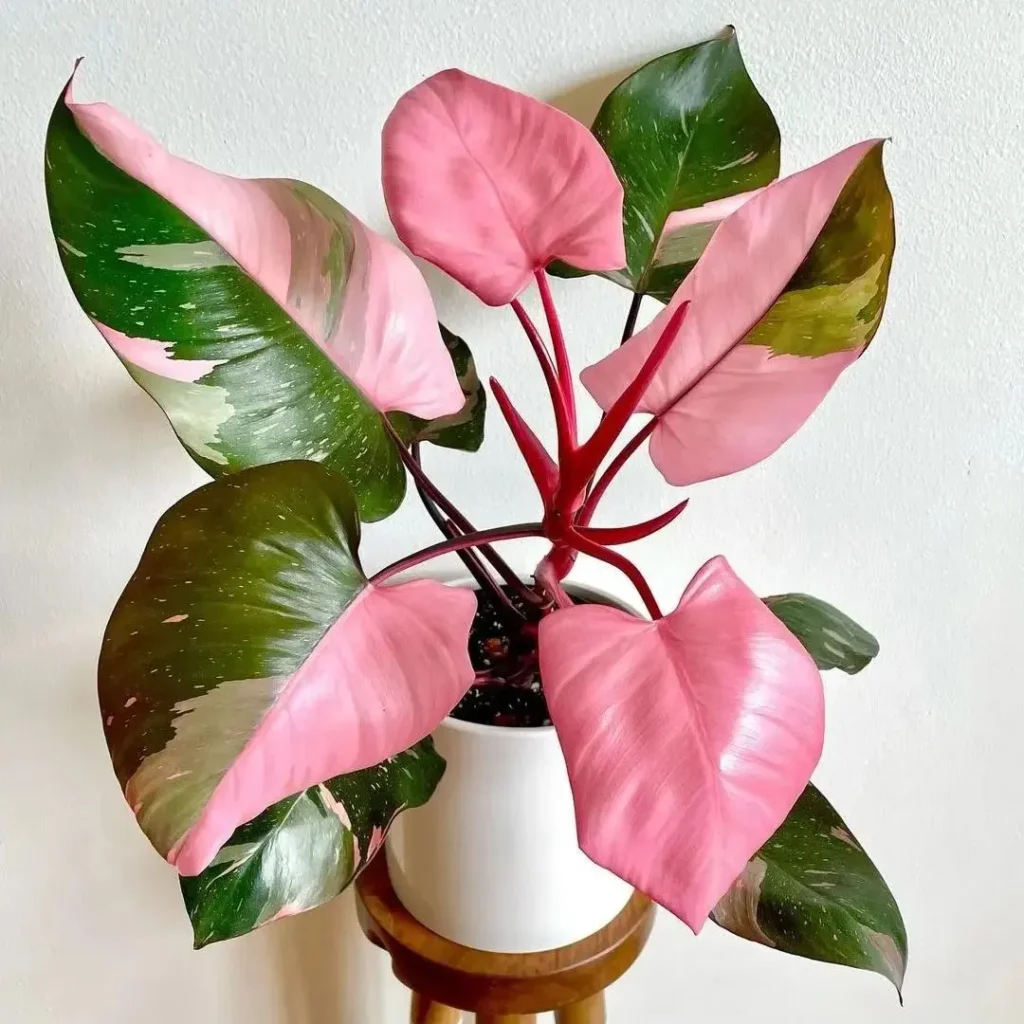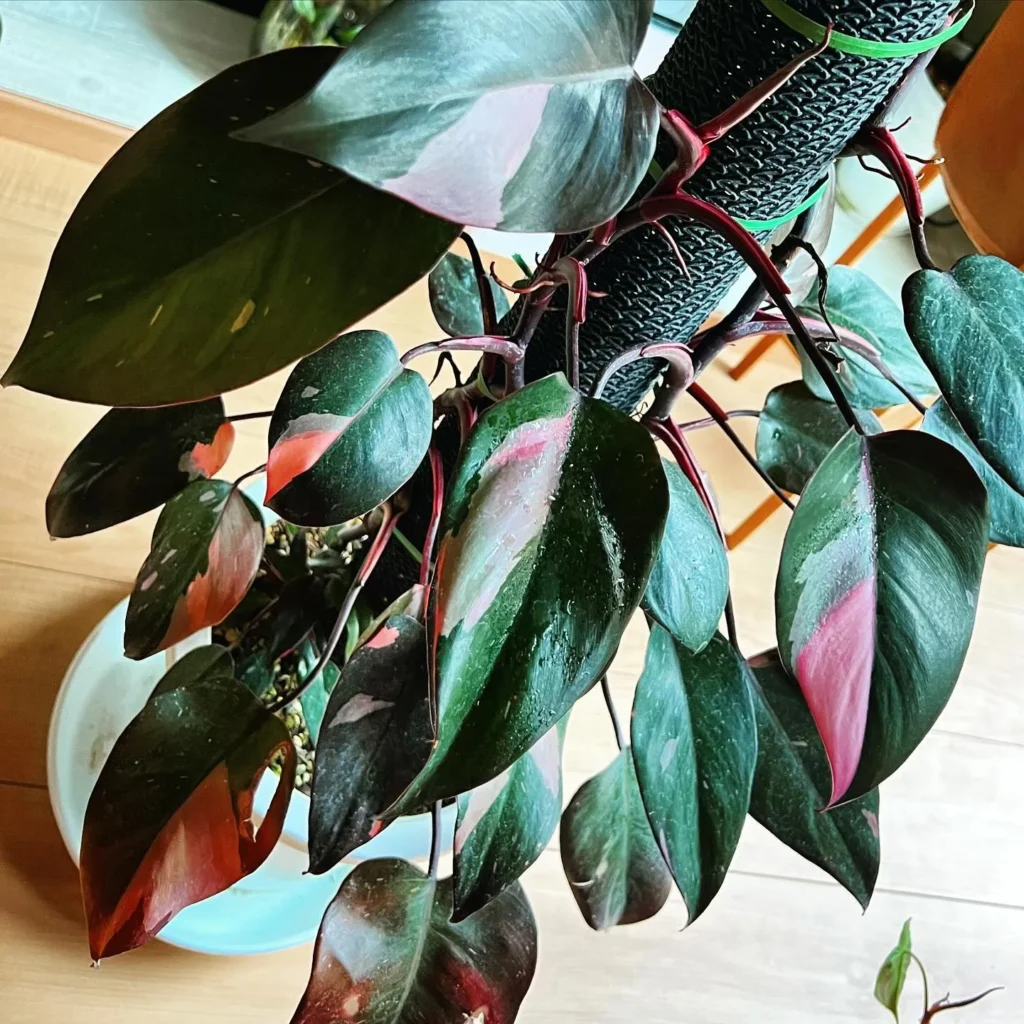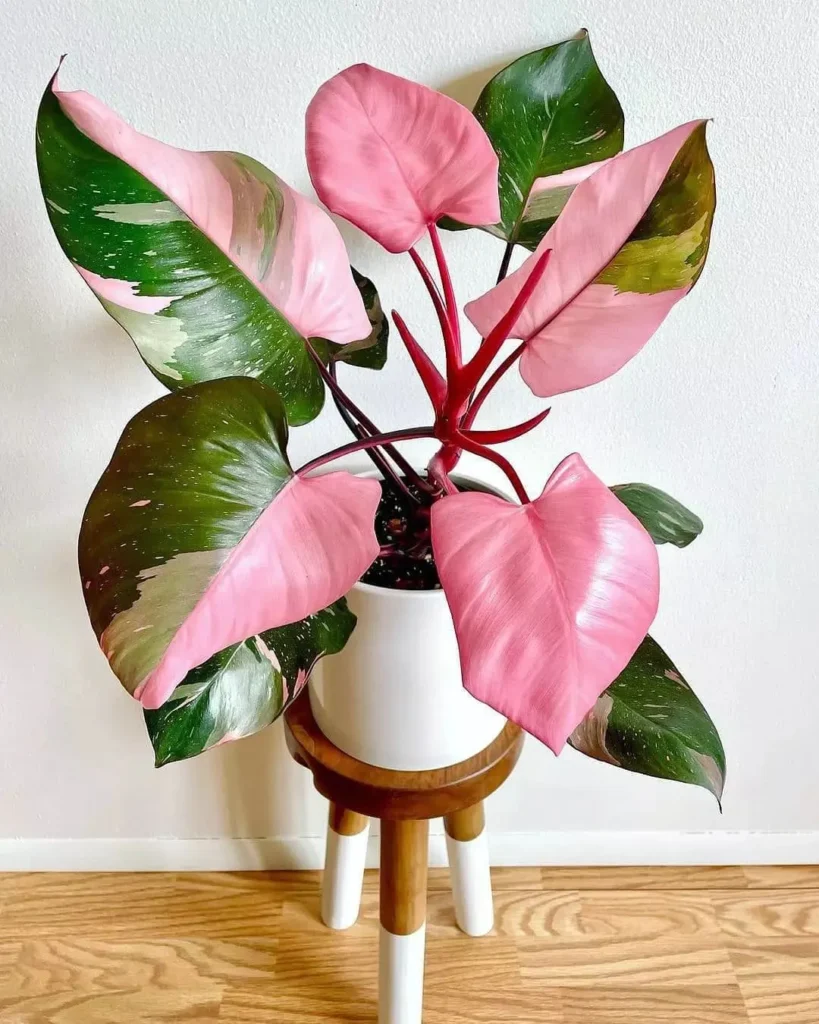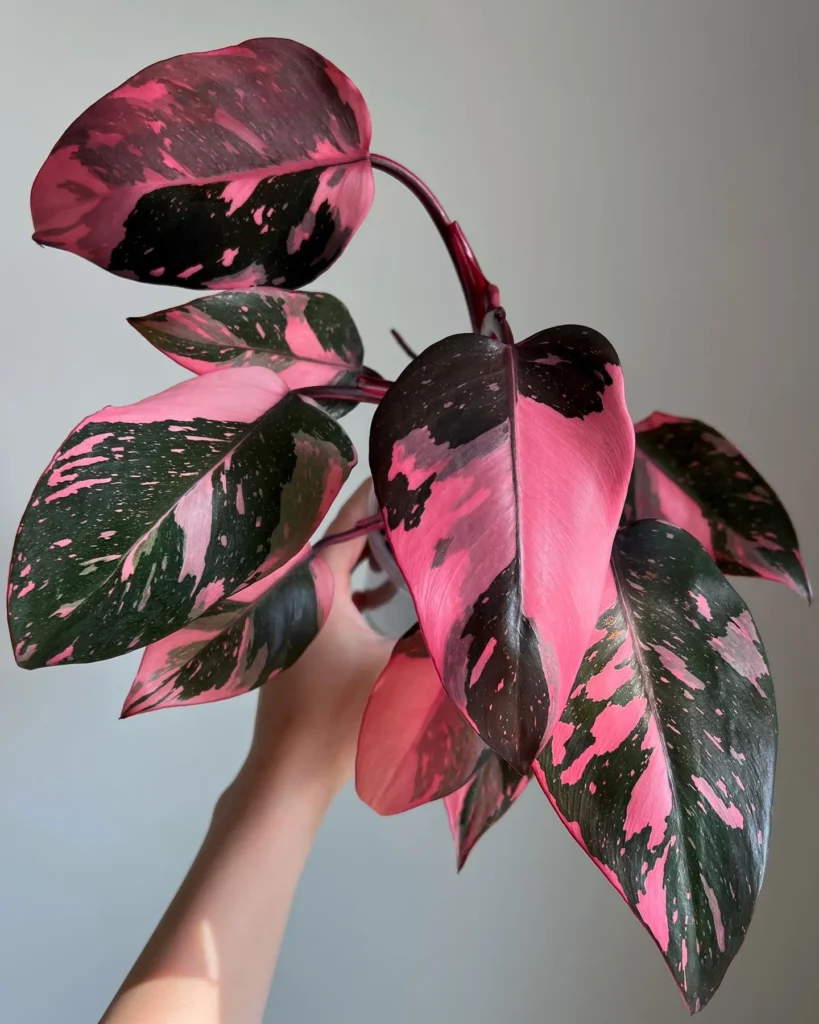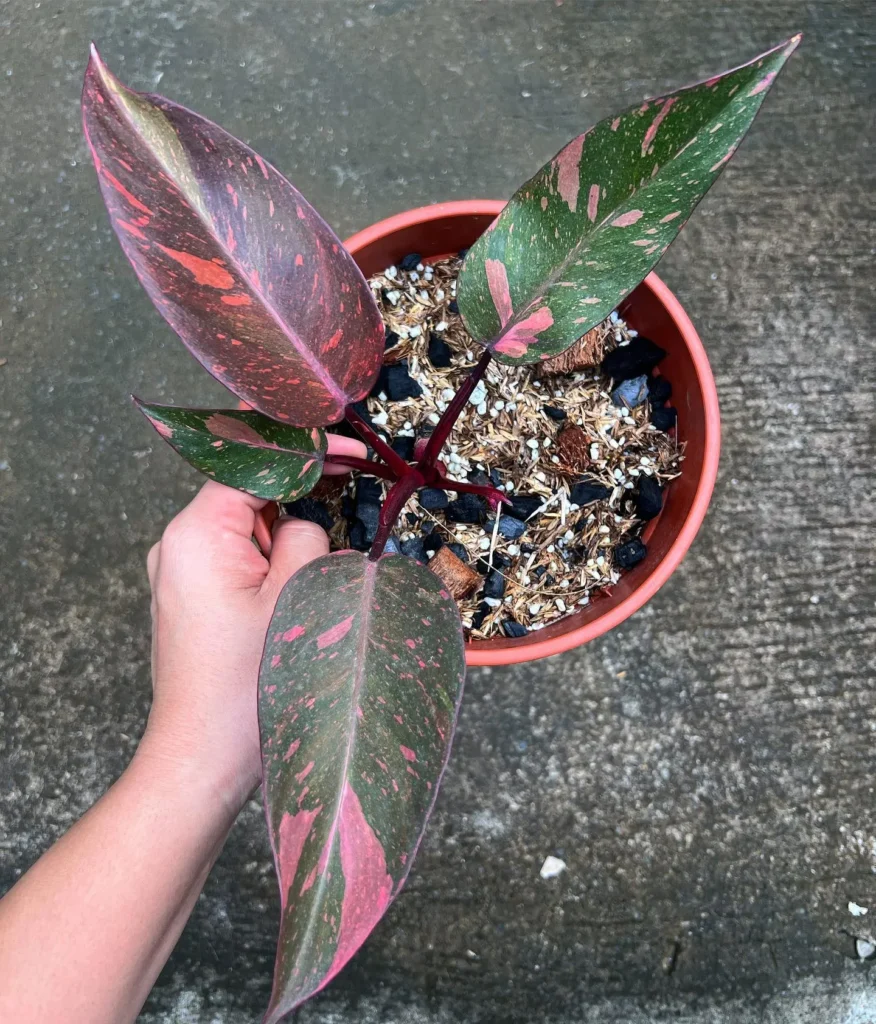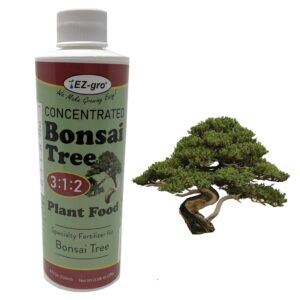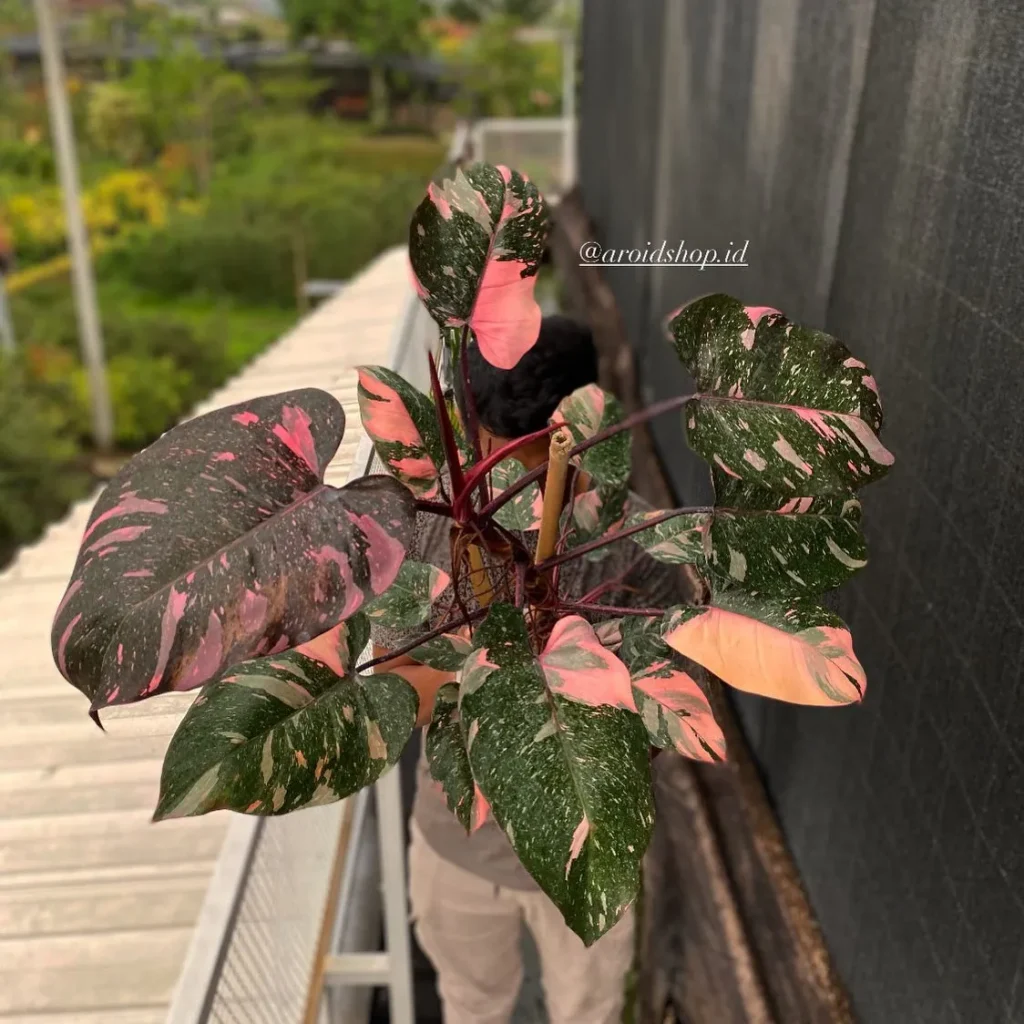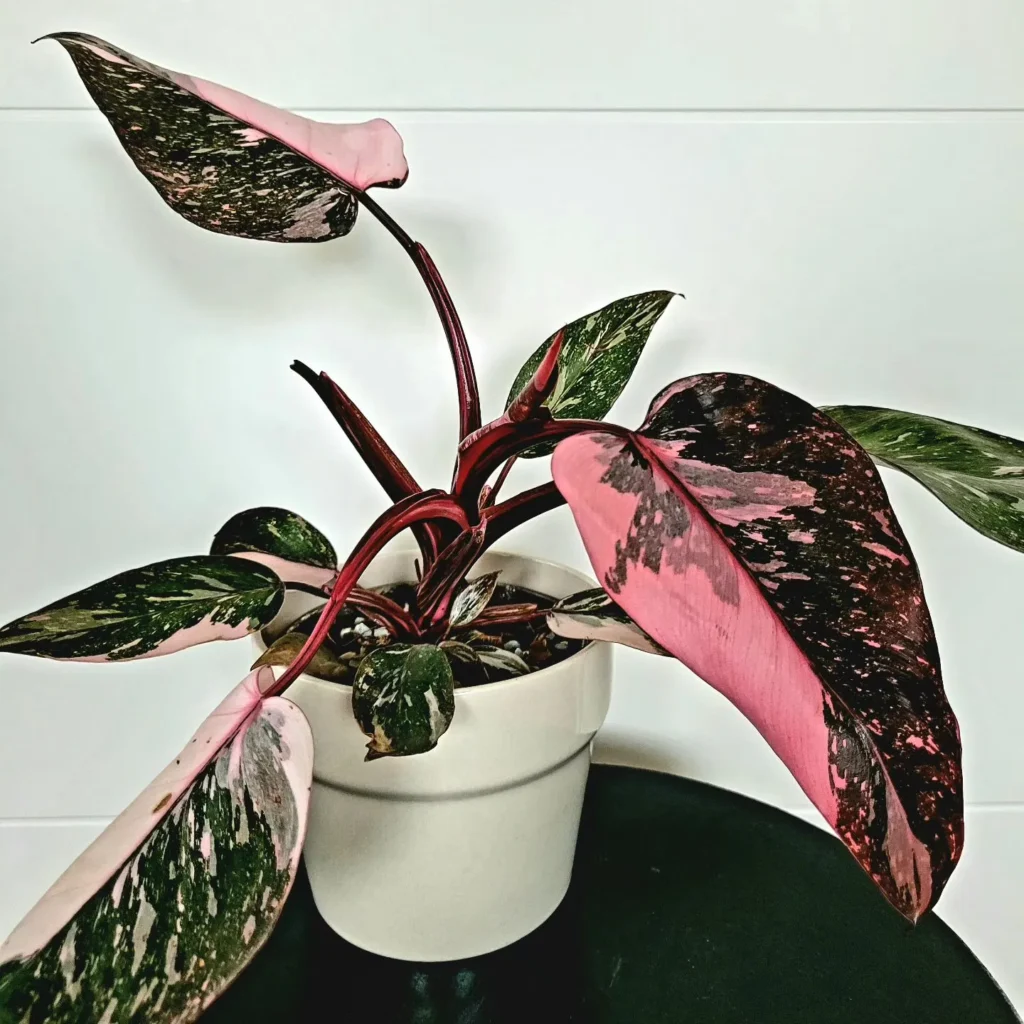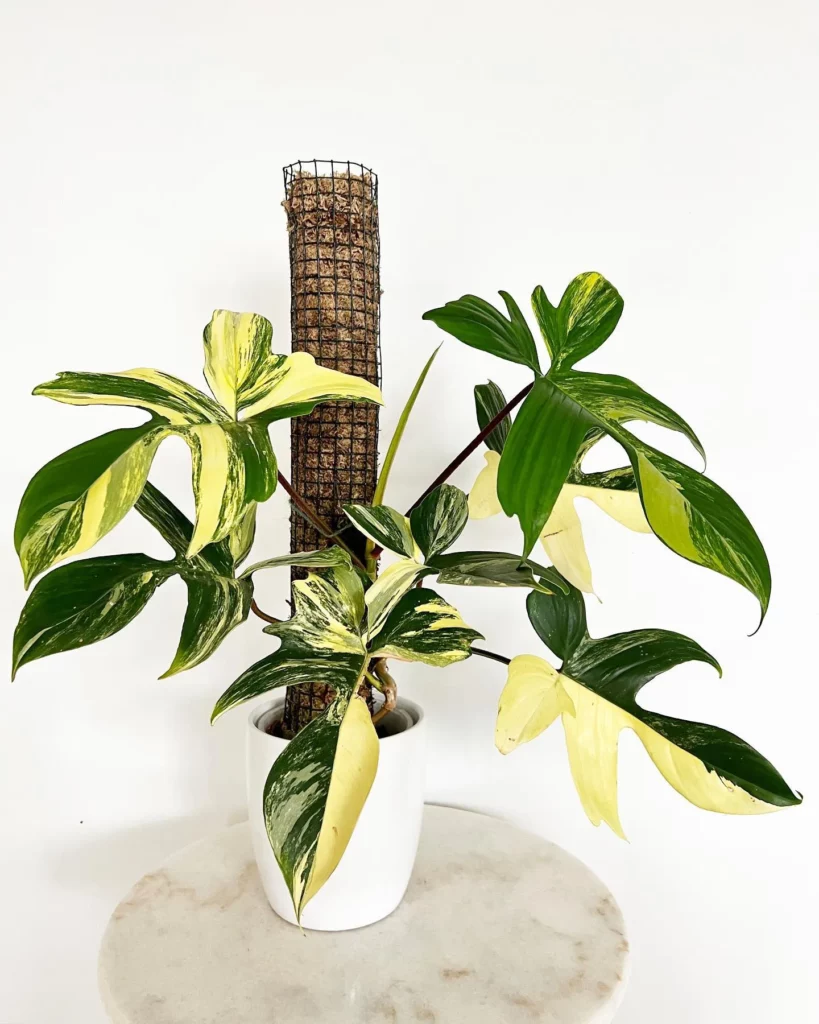Welcome to the ultimate guide on how to care for your Philodendron Pink Princess! This highly sought-after plant is known for its stunning deep green leaves with bubblegum pink variegation. With the right care, you can maintain the vibrant pink variegation and watch your Pink Princess thrive.
Key Takeaways:
- Provide bright, indirect light to maintain vibrant variegation.
- Water thoroughly, allowing the top half of the soil to dry out between waterings.
- Fertilize during the growing season with a balanced liquid fertilizer.
- Repot every 1 to 2 years, using a well-draining potting mix.
- Propagate through stem cuttings to create new plants and enhance variegation.
Appearance of the Philodendron Pink Princess
The Philodendron Pink Princess is a stunning plant with deep green, heart-shaped leaves that feature vibrant bubblegum pink variegation. The variegation is stable and occurs naturally in the plant, giving it a unique and striking appearance. The leaves of the Pink Princess can grow up to 4-5 ft. tall and 2-4 ft. wide, making it an eye-catching addition to any indoor space.
Key Features:
- Deep green, heart-shaped leaves
- Vibrant bubblegum pink variegation
- Stable variegation that occurs naturally
- Large size – up to 4-5 ft. tall and 2-4 ft. wide
Light Requirements for the Philodendron Pink Princess
Proper lighting is crucial for maintaining the vibrant variegation of the Philodendron Pink Princess. This unique plant thrives in bright, indirect light. Placing it in a location that receives several hours of bright, indirect light will ensure optimal growth and coloration. However, be cautious of exposing the Pink Princess to direct sunlight for extended periods as it can cause damage to the leaves.
If you don’t have access to a well-lit area, you can also invest in a grow light specifically designed for indoor plants. Position the grow light about 12 inches away from the plant and adjust the duration of light exposure according to the manufacturer’s instructions. This will provide the necessary light intensity for the Pink Princess to thrive and maintain its stunning variegation.
Tips for Light Requirements:
- Place the Philodendron Pink Princess in a location with bright, indirect light
- Avoid exposing the plant to direct sunlight for extended periods
- Consider using a grow light if natural light is limited
Watering the Philodendron Pink Princess
Proper watering is crucial for the health and vitality of your Philodendron Pink Princess. Maintaining the right soil moisture levels will help ensure the vibrant pink variegation of this stunning plant. Here are some guidelines to follow:
- Allow the top half of the soil to dry out between waterings to prevent overwatering.
- Water the plant thoroughly when it’s time to hydrate it, ensuring that the water reaches the roots.
- Avoid waterlogged soil, as this can lead to root rot, which can be detrimental to the plant’s overall health.
- When in doubt, wait another day before watering to prevent overwatering.
It’s important to note that the watering frequency will vary depending on the season and environmental conditions. In spring and summer, when the plant is actively growing, you may need to water it once a week. During fall and winter, when the growth slows down, watering once every 1 to 2 weeks should be sufficient.
Fertilizing the Philodendron Pink Princess
Proper fertilization is an essential aspect of caring for your Philodendron Pink Princess. By providing the right nutrients, you can promote healthy growth and vibrant variegation in your plant. Here are some important tips to remember when fertilizing your Philodendron Pink Princess:
- Use a balanced liquid fertilizer: When choosing a fertilizer for your Pink Princess, opt for a balanced liquid fertilizer with a ratio of equal parts nitrogen, phosphorus, and potassium (NPK). This will ensure that your plant receives all the necessary nutrients for optimal growth.
- Fertilize during the growing season: The Pink Princess is an active grower during the spring and summer months. To support its growth, fertilize your plant once a month during this period. However, it’s important to stop fertilizing in the early fall as the plant enters its dormant period.
- Follow the recommended dosage: Over-fertilizing can harm your Philodendron Pink Princess, so it’s crucial to follow the recommended dosage on the fertilizer packaging. Applying too much fertilizer can lead to chemical burn and damage the roots of your plant.
Potting the Philodendron Pink Princess
Proper potting is an essential aspect of caring for your Philodendron Pink Princess. When it outgrows its current container, it’s time to repot the plant to provide it with adequate space to grow.
Here are some tips to help you successfully pot and repot your Philodendron Pink Princess:
- Choose the right pot: Select a pot that is 2 to 4 inches larger in diameter than the current one. Make sure it has drainage holes to prevent waterlogging.
- Prepare the new pot: Fill the new pot with a well-draining potting mix. A mix of peat moss, perlite, and orchid bark can provide good drainage.
- Remove the plant from its current pot: Gently loosen the roots and carefully remove the plant from its current pot. Inspect the roots for any signs of damage or disease.
Tips for Light Requirements:
If the roots are circling the inside of the pot or appear crowded, you can trim them slightly to encourage new growth. Be cautious not to remove too much or damage the root system.
- Place the plant in the new pot: Position the Philodendron Pink Princess in the new pot, making sure the plant is centered and at the same depth as before. Add additional potting mix around the sides, gently firming it to provide support.
- Water and settle the soil: After potting, water the plant thoroughly to help settle the soil and remove any air pockets. Make sure the water drains out completely.
Propagation of the Philodendron Pink Princess
If you want to expand your collection of Philodendron Pink Princess plants or share the beauty of this unique plant with others, propagation through stem cuttings is the way to go. Not only will you be able to create new plants, but you can also encourage bushier growth and enhance the variegation of the leaves.
Here’s a step-by-step guide on propagating the Philodendron Pink Princess:
- Select a healthy stem with 2 to 3 leaves and 2 to 3 exposed nodes.
- Using sterilized pruning shears or scissors, make a clean cut just below a node.
- Remove the bottom leaves, leaving 2 to 3 leaves at the top of the cutting.
- Allow the cut edge to callous over for 12 to 24 hours. This helps prevent rotting when the cutting is placed in water.
- Place the cutting in a container filled with water, ensuring that the nodes are submerged.
- Put the container in a bright location with indirect light.
- Change the water every few days to prevent the growth of bacteria.
- Once roots have grown to at least 1 inch in length, transfer the cutting to a well-draining potting soil.
- Water the newly potted cutting thoroughly and place it in a location with bright, indirect light.
Growth and Development of the Philodendron Pink Princess
The Philodendron Pink Princess is a fast-growing plant that can reach impressive dimensions with the right care. Under optimal conditions, this plant can grow up to 4-5 ft. tall and 2-4 ft. wide.
Its vigorous growth rate means that it can produce a new leaf every month during its growing season, making it a visually stunning addition to any indoor space.
To promote bushier growth and maintain the desired shape and size of the Philodendron Pink Princess, pruning is recommended. Regularly trim back any leggy or overcrowded growth to encourage new shoots and a fuller appearance. However, be mindful not to remove too much foliage at once, as this can put stress on the plant and hinder its growth.
Potential Challenges in Growth
While the Philodendron Pink Princess is relatively easy to care for, it’s important to be aware of potential challenges that can affect its growth. Inadequate light or excessive shade can cause the plant to produce leaves with less pronounced variegation. To ensure vibrant and healthy growth, provide the Pink Princess with bright, indirect light and avoid exposing it to prolonged periods of direct sunlight, which can scorch the leaves.
Additionally, maintaining a consistent and suitable temperature and humidity level is crucial for the optimal growth and development of the Philodendron Pink Princess. This tropical plant thrives in warm and humid conditions, so aim to keep the temperature between 65-85°F (18-29°C) and the humidity around 60-70%. If the air in your home is too dry, consider using a humidifier or placing the plant on a tray filled with water and pebbles to increase moisture in its immediate environment.
General Maintenance and Monitoring
Regularly inspect your Philodendron Pink Princess for any signs of pests or diseases, such as mealybugs, aphids, spider mites, or root rot. Early detection and intervention are key to preventing the spread of pests or the development of diseases.
If you notice any issues, promptly take appropriate measures to control them, such as using organic insecticides or adjusting your watering habits to prevent overwatering.
Note: Be mindful of the Pink Princess’s growth rate and its potting needs. As the plant grows, it may require repotting to provide it with sufficient space for its expanding root system. Monitor the root growth and, when necessary, repot the plant into a slightly larger pot with well-draining soil.
Pests and Diseases of the Philodendron Pink Princess
The Philodendron Pink Princess, like any other houseplant, can be susceptible to pests and diseases. It’s important to be aware of these potential issues so you can take appropriate measures to prevent and treat them.
Pests:
- Mealybugs: These small, white insects can feed on the plant’s sap and cause damage. Regularly inspect your Pink Princess for any signs of mealybugs, such as white, cottony clusters near the leaf nodes. Use organic insecticides or remove them manually with a cotton swab dipped in rubbing alcohol.
- Aphids: These tiny insects can also feed on the sap of the plant, causing stunted growth and distorted leaves. Look for clusters of aphids on the undersides of leaves and remove them by spraying the plant with a strong jet of water or using insecticidal soap.
- Spider Mites: These tiny pests can produce fine webbing on the plant’s leaves and cause them to turn yellow or become speckled. Regularly misting the plant and keeping the humidity levels up can help prevent spider mite infestations. If they do occur, use organic miticides to control them.
- Scale: These small, oval-shaped insects can form hard shells on the plant’s stems and leaves. They feed on the sap, causing yellowing and dropping of leaves. Remove them manually with a soft brush or cotton swab dipped in rubbing alcohol.
- Fungus Gnats: These small, flying insects are attracted to moist soil and can be a nuisance. To prevent fungus gnat infestations, allow the top half of the soil to dry out between waterings and avoid overwatering. Using sticky traps can also help control adult fungus gnats.
Diseases:
- Root Rot: Overwatering or poorly draining soil can lead to root rot in the Philodendron Pink Princess. This can cause the roots to become mushy and black. To prevent root rot, allow the top half of the soil to dry out between waterings and use well-draining soil. If root rot occurs, remove affected roots and repot the plant in fresh soil.
- Rust Spot: This fungal infection can cause small rust-colored spots on the leaves of the Pink Princess. Avoid overhead watering and ensure good air circulation around the plant to prevent rust spot. If it does occur, remove affected leaves and treat the plant with a fungicide.
Conclusion
Remember to provide bright, indirect light to prevent the leaves from reverting back to green. Proper watering, allowing the top half of the soil to dry out between waterings, is crucial to avoid root rot. Fertilize during the growing season with a balanced liquid fertilizer, but be cautious not to overdo it.
Repot the Pink Princess when necessary, using a well-draining potting mix and a pot with proper drainage. If you wish to propagate the plant, stem cuttings are an easy and effective method. Keep a close eye for any signs of pests or diseases, and take appropriate measures to control them if necessary.
FAQ
What is the appearance of the Philodendron Pink Princess?
The Philodendron Pink Princess has deep green, heart-shaped leaves with bubblegum pink variegation.
What are the light requirements for the Philodendron Pink Princess?
The Pink Princess thrives in bright, indirect light and can tolerate a few hours of direct sunlight when grown indoors.
How often should I water the Philodendron Pink Princess?
Allow the top half of the soil to dry out between waterings and water thoroughly. Water once a week in spring and summer, and once every 1 to 2 weeks in fall and winter.
How should I fertilize the Philodendron Pink Princess?
Fertilize with a balanced liquid fertilizer during the growing season (spring and summer) and follow the recommended dosage on the fertilizer packaging.
When should I repot the Philodendron Pink Princess?
Repot the plant once it outgrows its current potting container, usually every 1 to 2 years, during spring and summer.
How can I propagate the Philodendron Pink Princess?
You can propagate the Pink Princess through stem cuttings. Select a stem with 2 to 3 leaves and 2 to 3 exposed nodes, remove the bottom leaves, and place the cutting in water until roots develop.
How big can the Philodendron Pink Princess grow?
With proper care, the Pink Princess can grow up to 4-5 ft. tall and 2-4 ft. wide.
What are the common pests and diseases of the Philodendron Pink Princess?
The Pink Princess can be affected by mealybugs, aphids, spider mites, scale, fungus gnats, root rot, and rust spot. Regularly inspect the plant for signs of infestation or disease.
Where can I buy a Philodendron Pink Princess?
You can find Pink Princess plants at specialty nurseries, plant shops, and online retailers. It’s important to buy from reputable sources to ensure healthy and highly variegated specimens.
What care tips should I follow for the Philodendron Pink Princess?
Provide bright, indirect light, use well-draining soil, water thoroughly but allow the top half of the soil to dry out between waterings, fertilize during the growing season, repot when necessary, propagate through stem cuttings, monitor for pests and diseases, and buy from reputable sources.


